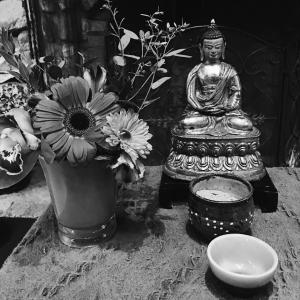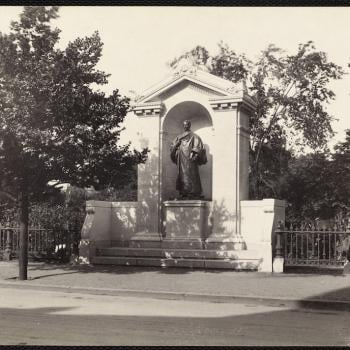There’s a saying floating around the interwebs, “We are all broken, that’s how the light gets in.” I like it. A lot.
I’ve always assumed it a slight misquote of the Zen poet and singer Leonard Cohen’s magisterial song Anthem:
Ring the bells that still can ring
Forget your perfect offering
There is a crack, a crack in everything
That’s how the light gets in
However, digging around I found it is sometimes actually attributed to Ernest Hemingway. Possibly that comes from a misremembering of a line in his novel A Farewell to Arms:
If people bring so much courage to this world the world has to kill them to break them, so of course it kills them. The world breaks every one and afterward many are strong at the broken places. But those that will not break it kills. It kills the very good and the very gentle and the very brave impartially. If you are none of these you can be sure it will kill you too but there will be no special hurry.
I also like that. I especially find my heart drawn to that part about being “strong at the broken places.” It echoes for me the Japanese art of kintsugi, mending broken pottery with lacquer mixed with gold (or other precious metals).
I believe both the crack being how light gets in and how the mending is in some way the strong place are true. Different angles on the same truth. And, there’s something more to it. More angles, yet. Deeper insights into the reality of our lives are constantly unfolding. And this is really important. For me these comments are themselves intimations of the way things actually are.
As a person on the Zen way, I find they point to the mysteries of the path. Of course it is something endlessly complicated, those many, many angles. And, with that more intimations, more invitations. Mark Epstein in his Thoughts Without a Thinker while about a Thai monk, tells that delightful story many of us who are Zen practitioners know by heart.
“You see this goblet?” asks Achaan Chaa, the Thai meditation master. “For me this glass is already broken. I enjoy it; I drink out of it. It holds my water admirably, sometimes even reflecting the sun in beautiful patterns. If I should tap it, it has a lovely ring to it. But when I put this glass on the shelf and the wind knocks it over or my elbow brushes it off the table and it falls to the ground and shatters, I say, ‘Of course.’ When I understand that the glass is already broken, every moment with it is precious.”
For me this invites further reflection. Those many angles. The whole and the parts. Form and emptiness. And, especially in the moment, those parts, those shards. Now this. Now that. I find myself thinking of Tevye’s many hands…
“I promise you, Rev Tevye, your daughter won’t starve.” It breaks my heart. It sings the mystery.
And.
A pledge. A vow.
So, the Zen teacher Eve Marko writes cites an interview with her husband the renowned Bernie Glassman:
The interviewer digs further: What does it mean, to be whole? Bernie looks straight into the camera. We had a big glass vase here, he tells the interviewer, and it fell and broke into a thousand pieces. Was it whole before it broke? I guess so, she says. And what about after it broke? She brightens. Well, I guess now it’s whole as a broken vase. More than that, he tells her. Every single broken piece is whole.
Here we get into the living thing. I sometimes like to say the fundamental insight of our lives is like that description of quantum mechanics. And, I don’t partiularly like hitching my religion to some current iteration of scientific speculation. But. Think of it as a metaphor. The image is called wave-particle duality. As I understand the theory it asserts that the fundamental building blocks of reality can from one angle appear to be particles, while from another it is all waves.
Now the building blocks of reality the physicists are talking about concern things too small to be of direct relevance at the particular size of things within which we live. But, as a pointer to our intimate reality, it does speak to how we in fact encounter the world. It speaks to our hurt. And it speaks to our healing. It describes the reality as we experience it and it invites us into a way of seeing and being.
My biggest problem with the wave particle image is how bloodless it is. I can miss the hurt and the healing. And. The problem is that it is in fact the whole of our lives, totally about the hurt. Totally about the healing. So, I don’t like to do more than add it in as one image among many. Like Hemingway’s strong breaks, and Cohen’s noticing of how we encounter the light. And, Achan Chah’s cherishing that cup. And, Bernie, activist and Zen teacher taken down by a stroke and now cancer, digging into the wholeness of the matter and the magical truth of the shards.
Sometimes we must attend to the whole. Sometimes to the particular. After all sometimes there is no other hand.
No other hand.
And. It is about a pledge. It is about a vow.
For those of us who practice Zen, particularly the koan way all this becomes quite intimate.
It is about not turning away from the whole great mess. As it presents. Living into it. Being it. The many and the one.
My friend the Zen teacher Dosho Port has been writing a very interesting series of essays on the Rinzai master Hakuin Ekaku. In his most recent posting he, Dosho, throws in the line “nondual embodiment.” I loved it and asked him where he picked it up. After saying he probably unconsciously stole it from someone, he admitted maybe he thought it up himself. Of course when we’re touching on this area of our wholeness and our brokenness we’re always lifting from someone else. There’s even a koan question, “Who is that other?” And, the answer must be from oneself.
That’s the dance of nondual embodiment. That’s the point of the pledge of not turning away. That’s the point of the vow to intimacy. It’s just about discovering who we really are and with that what we might become.
That’s the invitation for us all. To see the whole. To see the shards. To see the light, and the dark. To see the brokenness and the healing.
In this little reflection with perhaps too many quotes, here’s one more. From master Wumen:
The moon and the clouds are the same;
mountains and valleys are different.
All are blessed, all are blessed.
Is this one? Is this two?
Okay, one more. From Eve:
“Basically we’re broken, and each fragment is whole.”
We miss this and we find a world of broken shards, of hurt, of longing, of endless evils perpetrated upon the innocent. We understand this and the world is open, and endless possibilities arise.
Intimate. Intimate.
It’s that important.













